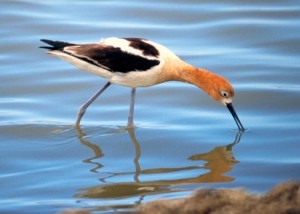
- Avocet breeding plumage (photo by Judy Irving/Pelican Media)
It's not often that a breaking levee hits the news and is cause for celebration.
But that's what's happening tomorrow when workers breach a levee in the former Cargill salt ponds in Hayward. It's a milestone for the 8-year-old wetland restoration project that covers 15,000 acres.
John Bourgeois, executive project manager for the South Bay Salt Pond Restoration Project, told KQED it's the project's first levee breach on the east side of the Bay.
Bourgeois says people near the bay will be able to see changes from this latest breach, just like they have from prior restoriation work on the project.
"We’re already seeing fish species in the far south bay that haven’t been there in decades. And [people] should see changes in bird use. At our project right at the foot of the Dumbarton bridge, they should see a lot more bird use than they’re used to."
The wildlife getting a boost includes two endangered species: the California Clapper Rail and the Salt Marsh Harvest Mouse. It'll also help the American avocet (pictured above) which started nesting on one of the project's newly created islands earlier this year.
With the breach of this levee, nearly one-fifth of the former salt pond will have been turned over to improve conditions around the Bay. It marks the end of the first phase of the project.
Bourgeois says 150 years ago the land used to be marshes open to the tidal influence of the bay.
"And when the salt producers came in they basically built these berms to block off the tidal waters from entering these areas so they could make solar evaporation ponds to evaporate water from the salt," he says.
Bourgeois says the San Francisco Bay is a very good place to produce salt. In the warm dry summers, stored water can be easily evaporated.
But Bourgeois says increased efficiency, improved weather forecasting and changes in the market meant that the salt ponds' owner Cargill didn’t need the same footprint to make similar quantities of salt. That's when the state and some private groups bought it for restoration.
Bourgeois says it's the largest tidal wetlands restoration on the west coast. "People are definitely watching this project," he says. Even in other parts of the country "like the Everglades project, and projects going on in Chesapeake Bay and those in the Great Lakes and coastal Louisiana. "
Incidentally NPR just posted a story about plans for a new wildlife restoration project in the Everglades.